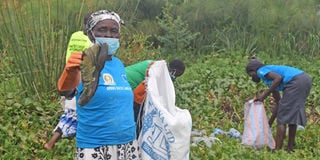From scenic views to filthy Lake Victoria shores

Mariam Asman displays a pair of shoes collected during a cleanup of Usoma Beach in Kisumu County.
What you need to know:
- 50 - There will be these millions of tonnes of plastic more than fish in oceans by 2050
- 20 per cent of fish in Lake Victoria has microplastics
- Plastics are known to cause injuries and some entangle the fish and mammals in the oceans and lakes.
The mouth of River Wigwa in Dunga is chocked. The river, which flows from Nyalenga slum to Lake Victoria, is full of water hyacinth, plastic bottles, used diapers, detergent bottles and all manner of waste.
When it rains, the plastic bottles and other waste, find their way into Lake Victoria. Over time, these plastic bottles have settled at the bottom of the lake.
The plastics get broken down by the elements over time. Larger pieces of plastic become smaller pieces called microplastics.
The microplastics are small enough to be ingested by aquatic animals, including those that end up on our plates.
Kisumu residents have started feeling the pinch of the plastic bottle menace at the lake.
Illegal excavation
Growing up in Usoma Beach, Michele Muchilwa says the beaches were beautiful to walk along and play on. This has ceased to be the case, with the illegal excavation of sand by the residents and plastic material scattered on the beach destroying the lake shores.
“Nowadays it is terrible. You walk along the shore of the lake and find plastics bottles, shoes, and containers everywhere. Some are floating on the lake,” says Muchilwa.
Some of the plastic waste is buried under the sand and it is tedious to collect it.
“Plastics have adverse effects not only on the environment and livelihoods but also human health,” says the 15-year-old student.
Miriam Asman, a resident of Usoma Beach, says for the longest time the fish catch has been dwindling due to the degradation of the lake. This drastic change in the lake environment has pushed her and other women to clean up the area. They collect the plastics from the lake shores for recycling.
“Initially, we used to get plenty of fish, but now we depend on fish from Usenge in Siaya County. We no longer have fish at Usoma except the juvenile, illegal catch. I used to collect the plastic bottles and later burn them. But, we realised it is was causing more air pollution,” says Asman.
For more than five months, she has accumulated tonnes of plastics from the lake shores.
Tom Mboya, another resident of Dunga and environmental activist with Friends of Dunga Swap organisation, says several fish varieties such as lung fish, cat fish and haplochromines (locally known as fulu), have started to disappear. This, he says, is because once plastics get into the breeding sites, they clog the area and suffocate the fish.
A study conducted in Mwanza in November 2015 estimates one in five fish in Lake Victoria have microplastics. Microplastics were in both Nile perch and tilapia.
Another study done by National Fisheries Resource Institute in Uganda in June 2020 says there are widespread microplastics in the surface waters of Lake Victoria in East Africa. The abundance of degraded plastic was highest in areas of the lake where there were intense human activities.
Side effects
Most of the microplastics were coloured, with sizes of 1mm, threatening the water quality and fish.
Kenya Marine and Fisheries Research Institute CEO, Prof James Njiru, has warned that by 2050 there will be more plastics than fish in the oceans and lakes. “The plastics will be about 50 million metric tonnes more than the fish pollution,” he says.
Often, he says, fish and birds mistake the small plastic particles for food. “Unfortunately, the fish feed on microplastics which end up on our dinner tables. Plastics are known to cause many side effects to human health,” he adds.
Similarly, plastics are known to cause injuries and some entangle the fish and mammals in the oceans and lakes.
“In terms of biodiversity, it is challenging to aquatic animals. It not only suffocates them but it also bloats their digestive system. We have been asking the government and stakeholders to pass plastic reduction policies and the industries to minimise plastic packaging,” says Prof Njiru.
National Environment Management Authority Kisumu County Director Tom Togo says they have implemented the law, with many offenders arrested for flouting it. “The plastic bottles end up blocking the flow of water at the river mouth. We have tried our best, but it is up to the consumers to change their plastic disposal habits,” says Togo.


